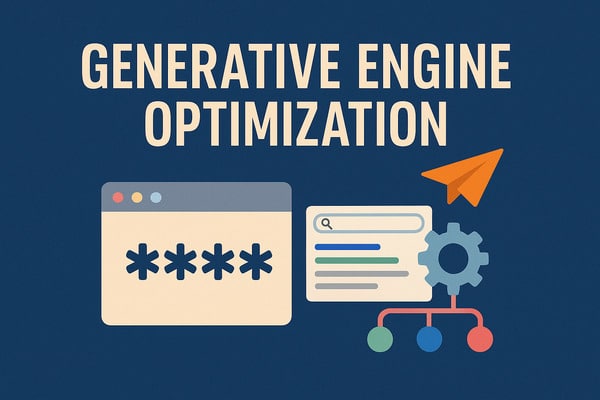Digital marketing sphere requires staying ahead with the new technologies, mainly for one’s own competitive advantage. Over the past few years, generative AI (algorithms that create text, images, audio, even video) has exploded in capability. But it’s not enough just to use such tools. To harness them for growth, websites and content need to be discoverable, useful, and trusted by both people and machines.
That’s where Generative Engine Optimization (GEO) comes in. Think of it as the next frontier of search, recommendation, content discovery, and AI‐driven user experience, blending traditional SEO with strategies specifically tailored for generative models, LLMs (Large Language Models), conversational agents, and other AI systems.
If you’re new to the idea, don’t worry. In this guide, we’ll walk you through exactly what GEO is, why it matters, and how to begin applying it for your business. By the end, you’ll understand how to ensure your website thrives not just in search engines, but in the age of AI generation.
WORTH KNOWING:
User engagement is one of the main criteria when it comes to generative AI platforms. Here, it plays even a more important role than in traditional SEO practices.
What Is Generative Engine Optimization (GEO): Definitions and Core Concepts
To begin, let’s define what we mean by GEO, and what it’s not:
- Generative Engines
These are AI systems capable of generating content (text, images, audio, or multi-modal combinations) based on inputs. Unlike traditional search engines, AI-driven search engines include LLMs like GPT, BERT, or Claude; image generation models; Chatbots; recommendation systems; voice assistants; etc. - Generative Engine Optimization (GEO)
GEO refers to the process of optimizing a website, its content, structure, and metadata so that content:- Can be consumed well by generative models (e.g. used as training material, or as inputs/feedback);
- Appears favorably in responses of those models (e.g. answers, summaries, chatbots);
- Is well‐positioned in more traditional search engine optimization / discovery channels (since many generative models draw on those).
- Differences of GEO vs. Traditional SEO
Traditional search engine optimization focuses on ranking in search engine results pages (SERPs), optimizing for keywords, backlinks, site speed, user experience, etc. GEO builds on that but has additional dimensions:- How clearly the content can be understood and repurposed by models according to to user queries (e.g. quality of prompts, clarity, depth);
- The role of context, semantics, entity linking, so content can be retrieved or ‘cited’ by AI driven search engines;
- Ensuring content is up‐to‐date, factual, well-structured – because generative engines can confidently generate misleading or incorrect content if inputs are poor.
WORTH KNOWING:
GEO optimizes content for AI-driven platforms and search engines. It also frequently employs signals from social media to rank and index content.
Why GEO Is Becoming Essential for Optimizing Content
Why should GEO matter to you, especially if you run or market a website? Well, here are some important points:
- Shift in Discovery Channels
More users are getting answers via AI assistants (chatbots, voice assistants, etc.) and AI-powered search engines rather than clicking through multiple search engine result pages. Generative systems often pull from content they were trained on or content they can access. If your content isn’t optimized for AI, it may never show up in those AI-generated responses. - Content Repurposing and Syndication via AI
Generative search engines may generate snippets, summaries, or knowledge panels (including visual and interactive elements) using content from across the web. That means content with strong authority, clarity, structure, is more likely to be used. This gives indirect visibility and trust. - Trust, Credibility, and Factual Accuracy
As generative AI becomes mainstream, users and platforms care more about the authenticity and reliability of content that appears through keyword research. Poor quality, outdated, or misleading user generated content risks being misrepresented or deprioritized. - Competitive Advantage
Businesses that adopt GEO early may benefit from higher visibility in emerging AI-driven discovery spaces (including search rankings), better search behavior responses, less competition, and more opportunity to shape how their content is used or presented.
Key Components of GEO Strategy
To do GEO well instead of employing traditional search engine formats, you need to build strategy around several pillars. Below are the key components.
Component #1. High Content Quality
- Depth, Originality, Clarity: Generative engines favor content that offers value, including unique insights, relevant keywords, careful explanations, well-researched facts, but not shallow or generic filler.
- Format and Organization: Using headings, subheadings, bullets, numbered lists, tables, and so on is important since it helps both humans and machines parse content and show it in response to semantic search.
- Consistency & Topical Authority: It is essential to build out clusters of content around particular topics so that the site signals authority and appears in search results.
Component #2. Semantic and Entity Optimization
- Entities & Schema Markup: Use structured data to mark up things like persons, organizations, products, events. This helps machines “understand” what your content is about.
- Semantic Relationships: Use internal linking, topic clusters, and entity linking (e.g. referencing related people/concepts) so content doesn’t exist in isolation.
Component #3. Prompt-Friendly and Useable Snippets
- Featured Snippet Style Content: Create concise answers to common questions. Generative models often draw from such snippets.
- FAQ and Q&A Sections: Provide direct, clear answers in natural language that align with how users might ask questions.
Component #4. Source, Credibility, Freshness
- Updating Content Regularly: AI systems prefer up‐to‐date info.
- Citing Reputable Sources: Use external links, quotes or references when appropriate.
- Sticking to Transparency: Show authorship, publication date, corrections etc.
Component #5. Technical Foundations
- Site Speed and Mobile Responsiveness: Still critical. Generative engines often use signals similar to traditional SEO: user experience matters.
- Clean Crawlability and Indexing: Ensure robots.txt, sitemap, canonical tags, structured URLs are well managed.
- API (Including Data Accessibility Where Relevant): If your site offers well-organized data via APIs or open datasets, that can improve how generative systems can access your content.
Component #6. Prompt Engineering for Owned Generative AI Engines
If your business uses its own chatbots, AI assistants, or generates content automatically, here’s what it is preferable to do:
- Create craft prompts carefully so that output draws appropriately from your authoritative content.
- Ensure fine-tuning (if used) is on clean, well-annotated content.
- Monitor generated outputs for quality, bias, correctness.
How to Implement GEO in Content Creation and Organisation: A Step-By-Step Roadmap
Here’s a practical roadmap for beginners to start applying GEO (or, in other words, generative AI tools) to their business website.
Step 1: Audit and Foundation
- Keyword & Topic Research but with a twist: think in terms of questions or utterances users might speak to AI assistants to articulate their search intents.
- Content Inventory: catalog existing pages, assess which are thin, outdated, redundant.
- Technical Audit: site speed, mobile friendliness, structured data, indexing issues.
Step 2: Content Rebuild and Enrichment
- Refresh existing high‐traffic content with better structure, updated data, FAQs, examples.
- Create new authoritative content in topical clusters (e.g. pillar pages + supporting articles).
- Introduce schema markup and other semantic signals.
Step 3. Optimizing for Generative Use
- Add Q&A/FAQ sections (since GEO focuses on them in many cases).
- Create content in ways that are easily excerpted (concise definitions, lists).
- Consider writing “promptable content” (namely, content with clear sections that answer potential prompts).
- When using generative tools to create content, ensure you verify facts and tie back to your immersive, high‐quality content.
Step 4. Integration with Special AI Tools and Touchpoints
- If you have or plan to build chatbots, voice assistants with natural language processing, internal knowledge bases: integrate your optimized content there.
- Potentially provide APIs or data endpoints or RSS data feeds.
- Monitor how your content gets used in consolidators, plugins, voice assistants on web pages, and so on.
Step 5. Monitor and Iterate
- Track metrics relevant for AI search engines.
- Observe what questions people ask in chat/voice/search relating to your topic and use them to drive new content.
- Keep content updated and prune what’s no longer accurate.
- Stay aware of how generative models evolve (please note that new ones may favor different signals).
Measuring Success and Avoiding Pitfalls
For any new strategy, you need to measure performance and avoid common mistakes. Check more about it below.
Measuring Success
Some helpful metrics and indicators that your GEO strategy is working:
- Visibility in Search and AI Answers: Are your pages appearing among featured snippets, “People Also Ask” boxes, voice‐search responses, or AI chat answers?
- Increased Traffic and Engagement: Organic search traffic, time on page, bounce rate, return visitors.
- Query and Prompt Discovery: Monitor search console or any logs of chatbot or voice assistant interactions to see what queries users are using. If many match your content, that’s a good sign.
- Referral and Backlink Profile: As content is used or referenced, getting more organic mentions helps authority.
- Conversions and Business Outcomes: Leads, sales, newsletter sign-ups, or whatever your goals are.
Avoiding Pitfalls
Here are pitfalls to watch out for:
- Relying Too Heavily on AI-Generated Content Without Oversight: Poor content can spread misinformation or degrade your brand.
- Keyword Stuffing or Trying to “Game” Prompts: Generative engines are getting better at detecting superficial or manipulative content. Quality matters.
- Ignoring User Intent: Just because people may phrase things differently when talking to bots or voice assistants doesn’t mean you abandon clarity. Always put user need first.
- Neglecting Updates: What was accurate a year ago may be outdated now. Fact checking is ongoing, no matter whether we are talking about keyword usage, brand mentions, or other organic search metrics.
- Mind Privacy and Ethical Issues: If your content incorporates user data or personal info, ensure you respect privacy and legal constraints. Also, avoid biased or discriminatory content.
Conclusion
Generative Engine Optimization is rapidly moving from niche curiosity to a core capability for businesses that want their websites to succeed in a world where AI not only searches, but generates, answers, and assists. By treating your content not just as something humans read, but as something machines consume, repurpose, and reference, you position your business for greater visibility, trust, and growth.
If you’re feeling that the gap between traditional SEO and GEO is a bit wide, or you want expert help making sure your content, site structure, and AI touchpoints are optimized, IntlTech, a leading digital marketing agency, is ready to help. We can work together to audit your site (through a detailed data analysis), build out the right content strategy, and ensure your business flourishes in this new era of generative discovery.






